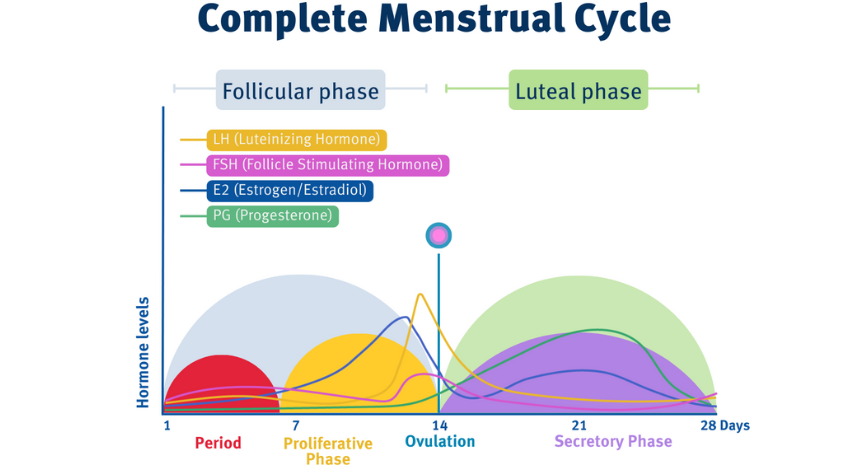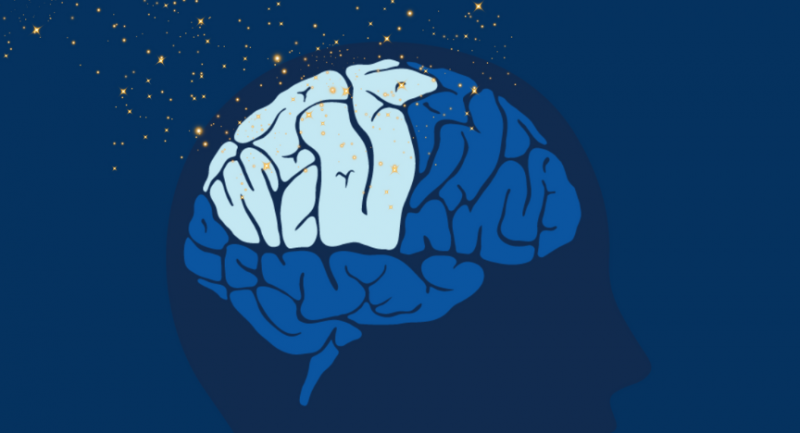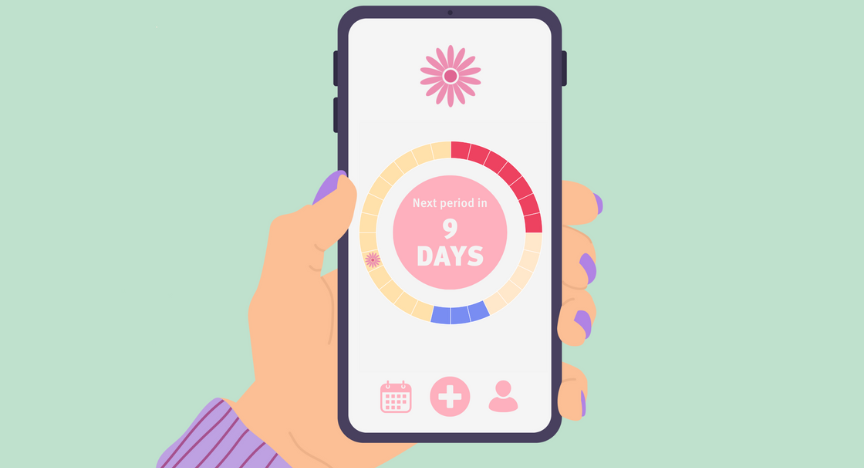
Feeling like a rollercoaster of emotions every month a week before your period?
You're not alone. PMDD is a real condition that's more than just bad PMS (premenstrual syndrome). Here we will break down what PMDD is, the risk factors and signs to watch for, and how to take back control of your cycle (and your sanity!).
If you get your period, you will be familiar with the symptoms of PMS. PMS describes the changes that happen a week before your period each month.
The symptoms include mood changes, bloating, acne, tiredness and headaches. These are usually manageable with lifestyle changes or medication. If you're curious about the science behind your menstrual cycle and the various PMS symptoms, listen to our latest podcast episode on periods from the It Can’t Hurt To Ask podcast.
Okay, let’s get back into why you’re here:
What is PMDD?
PMDD is a severe form of PMS that causes emotional and psychological distress. It can be so serious that it can impact a person’s daily life. Those with PMDD find normal activities such as work or school, exercising, or self-care difficult. It sometimes triggers thoughts of suicide and self-harm.
Although it's related to the menstrual cycle, PMDD isn't believed to be caused by a hormonal imbalance. Researchers think PMDD may be triggered by the hormonal changes in the part of the menstrual cycle between ovulation and menstruation (luteal phase).
After ovulation, follicle stimulating hormone (FSH) and luteinising hormone (LH) drop. Progesterone (PG) and oestrogen (E2) start to rise (refer to the graph below), and this contributes to PMDD symptoms. These symptoms can last for one to two weeks. The oestrogen and progesterone levels drop when the body is ready for another period.

Risk factors
PMDD has been recognised as a psychological condition since 2013 and is the only type of premenstrual disorder in the Diagnostic and Statistical Manual of Mental Disorders (DSM-5).
So, what exactly makes someone more likely to get PMDD? Here are the risk factors:
- Hormonal changes: studies show that those with PMDD are very sensitive to hormonal changes that occur during the menstrual cycle.
- Serotonin deficiency: serotonin is the brain hormone that controls your mood and makes you feel happy.
- Genetics: having a close relative with PMDD may raise your risk.
- Mood disorders: if you or a family member has depression, anxiety, or other mood disorders, you may be more likely to experience PMDD.
- Smoking: while the evidence is weak, smoking could be a risk factor for PMDD.
- Early childhood trauma: research suggests that 83% of Australians with PMDD had experienced trauma early in life. People with PMDD are more likely to have experienced physical, sexual, or emotional abuse or neglect in their past compared to the general population.
- Gender dysphoria: women who experience gender dysphoria are also at a higher risk of PMDD.

Signs and symptoms
PMDD can sometimes be misdiagnosed as some PMDD symptoms mimic other conditions. It can be confused with bipolar disorder, thyroid conditions, personality disorders or depression. With PMDD, symptoms overlapping with these disorders occur only on the days between ovulation and the end of a period.
Like PMS, the symptoms of PMDD usually appear around a week or two before a period. They will then settle down a few days after the period starts.
PMDD may cause the following symptoms:
- extreme or sudden mood changes and emotional sensitivity
- irritability or anger
- depressed mood -- feeling hopeless, worthless, or guilty
- anxiety, tension, or feeling ‘on edge’
- little or no interest in usual activities (work, school, friends or hobbies)
- difficulty concentrating or focusing (brain fog)
- tiredness, low energy or excessive sleepiness
- appetite changes, food cravings, overeating, or binge eating
- insomnia (trouble falling or staying asleep)
- feeling overwhelmed or out of control
- physical symptoms -- breast tenderness or swelling, joint or muscle pain, bloating or weight gain, acne, headaches.
PMDD can feel different from person to person.
Some report feeling very sensitive to everything around them. Everything they feel can be extreme, from lights to sounds, even thoughts and actions.
Others experience severe depression and panic, self-doubt or rejection sensitivity. Some feel like they’re not good enough and are unworthy of love. They can struggle with relationships and friendships.

Diagnosis
A PMDD diagnosis can only be made if someone has at least five symptoms for two or more menstrual cycles. One or more of the symptoms must be emotional or mood related (one of the first four symptoms listed in bold above).
If you think you have PMDD, the best way to understand what's happening is to keep a detailed diary of the symptoms and when they occur. The easiest way to keep track is to download a cycle tracker app on your mobile device. You can show this record to your healthcare provider.

Management and treatment options
There are a few ways PMDD can be managed. It does however depend on the severity of the symptoms and how they impact a person’s everyday life.
It’s best to discuss the various treatment options with your healthcare provider. Together you can figure out what will suit your lifestyle and situation.
One option that may help ease symptoms are SSRIs (selective serotonin reuptake inhibitors). These antidepressants can improve symptoms by boosting brain chemicals. SSRIs are usually prescribed only for the luteal phase of the menstrual cycle when symptoms are present.
The combined oral contraceptive pill may also have positive results. It stops ovulation and stabilises the hormonal changes during the menstrual cycle. Some find that this reduces PMDD symptoms.
In some cases, when nothing else has worked, the surgical removal of the ovaries (bilateral oophorectomy) may be considered. Sometimes the uterus can be removed (hysterectomy) at the same time.
If both ovaries are surgically removed, hormone replacement therapy (oestrogen and progesterone) is necessary. This reduces menopausal symptoms that come with the fast drop in hormones.
There are a few other helpful options that don’t involve medication or surgery:
Exercise and physical activity
Exercise increases the level of serotonin in the brain. The most effective type of physical activity you can do to help PMDD is aerobic exercise.
Aerobic exercise is any type of cardiovascular conditioning, or “cardio”. This includes activities such as brisk walking, swimming, running, or cycling. You must do at least 30 minutes of aerobic exercise to get the serotonin 'high'.
Reduce stress levels
Research has shown that stress may make symptoms of PMDD worse for some people. It can lead to ‘increased rumination and self-focused attention’. Rumination involves repetitive thought patterns. These happen when people try to process their emotions but become 'stuck' in negative thought patterns. They will often replay painful memories without progressing through to resolution. Rumination is common in people with unresolved trauma histories.
Some of the following stress reducing activities can help to ease PMDD symptoms if used as part of a daily routine.
- Exposure to bright light is one method that can help feelings of depression in those with PMDD. Light therapy or light exposure can help to balance serotonin in the brain. Opening your blinds and curtains when you wake up can lift your mood. So let that light in every day!
- Yoga is an excellent way to calm the mind and body. It can improve your general health and help to decrease anxiety and depression. Yoga increases serotonin which makes the body more relaxed.
- Controlled breathing and meditation both help to reduce depressive symptoms. There are many apps available that can guide you in controlled breathing techniques. All you need is a quiet, comfortable spot with no interruptions. Basic breathing exercises involve breathing in and out deeply and slowly for several minutes. This slows the heart rate and focuses the mind.
Psychological support
Accessing a mental health clinician can help to deal with past trauma. This may be a significant contributing factor to distress associated with PMDD. This trauma can stem from early life experiences such as physical, sexual or emotional abuse and/or neglect.
Dietary changes
Some with PMDD say their symptoms settle after changing their diet.
These foods help to balance blood glucose levels, lowering cravings and increasing mood and energy:
- fruit and vegetables
- good quality proteins (including meat, but especially fish)
- healthy fats (including avocado, nuts and olive oil)
- complex carbohydrates (like legumes, whole grains and quinoa).
Some foods to avoid in the luteal phase of the menstrual cycle are bread, pasta and refined sugar. They are simple carbohydrates that will increase blood glucose levels too quickly. Eating these foods will also lead to fatigue and low mood.
Reduce caffeine and alcohol
Many of those with PMDD have said that cutting back on or quitting caffeine has been the best choice they ever made.
Caffeine intake (especially if it’s more than 400mg per day) can increase the body’s cortisol (the stress hormone). It can also affect sleep patterns and increase heart rate and blood pressure. This can negatively influence your mood and increase feelings of anxiety. To help your PMDD symptoms, try reducing the caffeine you drink or cutting it out altogether.
Reducing or stopping the consumption of alcohol may also help settle the symptoms of PMDD. Drinking alcohol can boost your serotonin at first, giving that euphoric feeling. Serotonin levels will then drop, which can worsen feelings of anxiety and depression. If you already have low serotonin due to PMDD, excessive alcohol intake can make symptoms worse.
Take vitamins and herbal supplements
Many people with PMDD report positive experiences with taking vitamins and herbal supplements for symptoms. These supplements help to support (not replace) a healthy, balanced diet.
Supplements that can help relieve PMDD symptoms include:
- magnesium glycinate or magnesium citrate
- vitamin B6
- zinc picolinate
- calcium
- chaste tree or chasteberry (vitex agnus-castus).
Any supplements you take will potentially have side effects. They may also not mix well with certain medications or affect you differently if you have a medical condition.
It’s always important to speak to your doctor before taking anything to ensure it’s right for you. Your doctor might suggest a blood test before supplementing, so the correct dosages can be recommended.
Getting help
Many people with PMDD symptoms feel alone, frightened, and unsure if what they are going through is normal. If you've read this and think you may have symptoms, make an appointment to see your healthcare provider. You can also call Lifeline on 13 11 14 for immediate support.
More information
- International Association for Premenstrual Disorders (IAPMD)
- Premenstrual Dysphoric Disorder (PMDD) | Johns Hopkins Medicine
- Is Premenstrual Dysphoric Disorder (PMDD) Real? | Psychology Today
- Premenstrual syndrome (PMS) | Better Health Channel
- Premenstrual syndrome (PMS) | Jean Hailes
- The prevalence of early life trauma in PMDD I Psychiatry Research